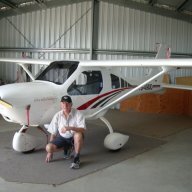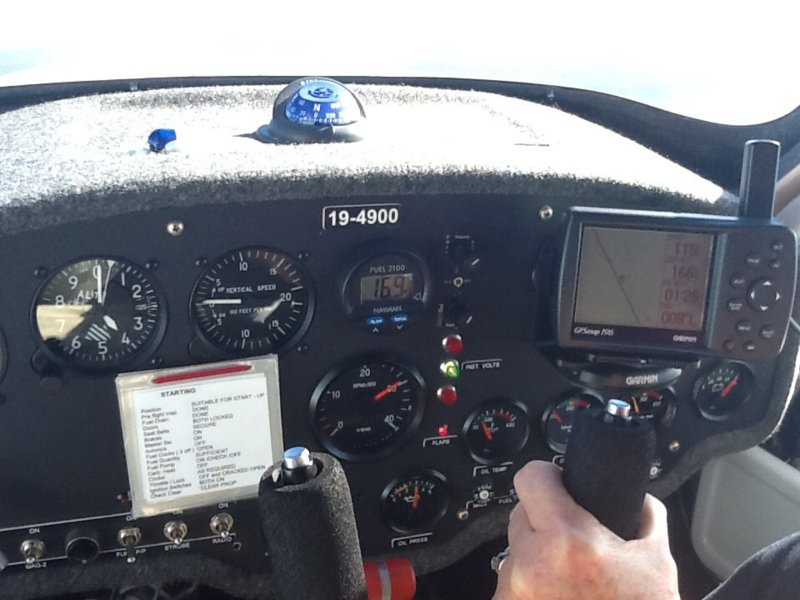-
Posts
1,067 -
Joined
-
Last visited
-
Days Won
4
Content Type
Profiles
Forums
Gallery
Downloads
Blogs
Events
Store
Aircraft
Resources
Tutorials
Articles
Classifieds
Movies
Books
Community Map
Quizzes
Posts posted by biggles
-
-
. CAAP 233-1(1) details rules regarding IPad mounting and in particular suction mounts .
Bob
-
Hmm , nice looking 230 Frank .
Bob
-
She must be something Maj. ...... Frank's even wearing shoes !
-
 1
1
-
-
Hey Frank ..... You never told me about that one !
Bob
-
Also what causes more accidents ? Pilot error or pilot age related incapacitation?
Human factors !
-
Oh dear , so much mis information . Both 6 and 4 cyl.Jabiru engines have the same 17 Amp alternator , and this has been the case for around 10 years to my knowledge . The starter motor draws around 1.5 kw and is supplied from the battery , the same set-up as the family car . The alternator replenishes that expended energy over time . Camit have always made engines for Jabiru and appear to be offering some options to the standard Jabiru engines . I have no idea what the agreement/arrangement is between Camit and Jabiru . There is a wealth of good information on the Jabiru website regarding all aspects of their engines and airframes .
Bob
-
What was the " simple cure "Might seem a silly question bur are you 100% sure its aileron flutter? Just asking because the strut fairing has caused similar effects on a number of Jabiru's in SA. I had violent shaking from the wings which would occur at about 100 knots, to make it worse it did not occur all the time but once it started the only way to stop it was reduce steed to +-85 then go back up to 95+. I also thought it was aileron flutter, really worried me until I found out that it was the strut that was fluttering and the cure was very simple. (and I think now standard on our factory aircraft, well it was standard on my new J170.)Cheers.Bob
-
Ian ,
Was the flutter there before changing to the Rotax ?
Bob
-
My reply is a bit dodgy coz I'm texting while driving in Pacific Highway traffic...

-
Yes , try to stay in balance at all times with ALL fuel taps fully open . One less thing to worry about if something else happens to grab your attention . Most Jabs seem to drain tanks unevenly .Speaking from my own personal experience here....fuel management isn't something that was covered at all in my training. It was covered in planning obviously, but not during flight. That said I learnt to fly on a trike which has one fuel tank and a fuel tap that as pilot you cant get to in the air so inflight management involved looking at time spent with the motor on and nothing else.The J160 that I did my 10hr conversion from flexwing to fixed wing only had a single fuel tap so again was pretty much the same as the trike. My J230 has 3 taps, a common one near pilots leg and one on each pillar for each wing. As others have said, newer 230's don't have them. My fuel gauges are simply sight tubes that rock around in turbulence and its pretty difficult to take a meaningful measurement from them except in Hollywood weather..... Common advice with the J230 is to fly balanced otherwise fuel will feed from one wing more than the other (or more accurately will transfer from one wing to the other via the connecting line between the 2 wings......I have not seen any advice that says in a J230 you should fly 15 minute segments on 1 wing then the other etc etc when going long distance xcountry..So I wonder if my training was simply deficient, compared to say GA......I don't know what I don't know
Andy
Bob
-
Andy
I have seen, on a Rotax actually which was subjected to higher vibration, lock wire through the springs and securing points. The lock wire was not tight but only to stop excessive movement should a spring fail. It seemed like a good and simple idea to me...........
I have always done this Frank , and like you say ...... " a good idea " . Andy for what it's worth I have not shut those fuel taps for many years , after a near miss similar to yours . I seem to recall Jabiru stopped installing them years ago for whatever reason . These days I just rely on the main beam isolating tap . The pre - start check lists are , I believe ,essential as it is easy to get distracted or complacent , due to familiarity or whatever - " Human factors " at play . Even though I never shut those taps , they are still a part of the check list as you may see in the pic. ......... " Fuel taps - 3 off -- OPEN " -
Just about everybody is younger than me Maj .He's a lot younger than you or I Biggles !.............
-
Somewhere I have seen the definition of "Final Approach"......It's along the lines of- VFR pilot in a single engine aircraft, flying IFR on a moonless night below minimums .
Mmmm , a bit like those who say " if you're not living on the edge you're taking up too much room "
Bob
-
 1
1
-
-
" hooning around " ........... Really ?
-
Ian ,
The symptoms you describe are unusual and should not be tolerated . Some simple checks will reveal where the problem is , such as having someone hold the control column firmly while another tries moving the aileron ( in the up,down and neutral positions ) Also remove the perspex cable clamp inspection cover under the wing ,to ensure the cable clamp is the correct one for that particular cable, and is firmly located . Another check would be to unbolt the spherical bearings at each end of each control cable and check for full travel ,any sloppiness or uneven resistance in the cable . Maximum 'slop' should not exceed 3 mm . Also check for control column looseness , and any movement in yoke at rear of column where the aileron cables attach . Any one ,or a combination of these faults ,will result in 'flutter' and should be rectified..... " before next flight " . At these hours I would also be checking the wing root ,and strut attachment bolts , by firmly shaking the wing to detect any movement .
Bob
-
 1
1
-
-
Well done Ross . I'm sure the NQ members will feel that they are getting good value for their dollar .
Bob
-
Jabiru are getting good performance .... rate of climb , cruise performance etc. from their new composite prop , although it will require a new spinner on the 160 . Suggest you contact them for more details .
Bob
-
Don't doubt you but nothing on the RAAus website
Bob
-
Nothing in the ATSB reports yet . Any idea what the a/c was ?
Bob
-
' Sprung ' ..... Last seen heading back to Rio !
Bob
-
 1
1
-
-
G'Day Sean ,
Nice to hear from you again , and Tony , I am sure you will be impressed with Sean and the guys at Gofly Aviation .
Bob
-
Thanks for that report Ross . A lot of people there doing their best , under less than ideal circumstances , for us members .
Bob
-
G`Day Bob,
 , You`ve been lying low for a while! Hope you and Sal all good!
, You`ve been lying low for a while! Hope you and Sal all good!Yeah Frank all good here . Will email you soon
Bob
-




Around Australia in a Jabiru
in Jabiru
Posted
Just got mine also . Bob